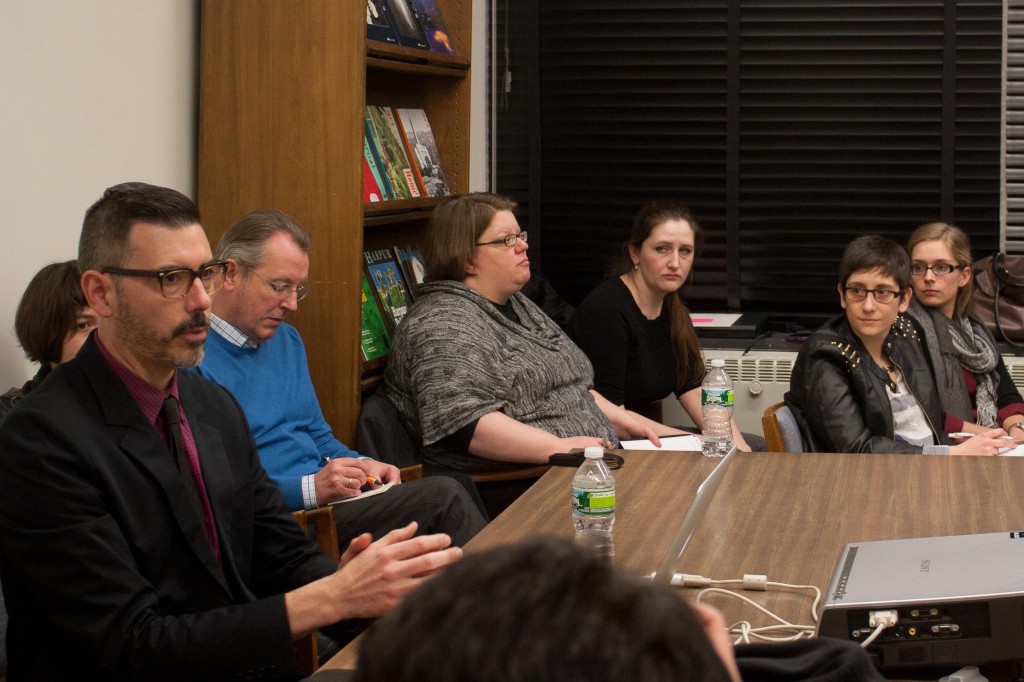
Award-winning and nationally recognized architect Jonathan Massey addressed the impact of social media and technology at a lecture on campus Wednesday, dissecting how it has affected contemporary social movements like Occupy Wall Street.
Massey’s presentation was part of the Harpur College Dean’s Speaker Series in Visual Culture. It focused on how mapping software, mobile phones and social media have made it easier to analyze the spatial patterning and organizing strategies of social movements, focusing on the Occupy Wall Street movement centered in Zuccotti Park in Lower Manhattan in 2011.
Professor Massey, an associate professor for the School of Architecture at Syracuse University, is a co-founder of the Transdisciplinary Media Studio and Aggregative Architectural History Collaboration, architectural projects that use digital mapping to simulate significant old physical structures important to history, art and culture. He also authored the recent paper “Occupying Wall Street: Places and Spaces of Political Action,” which focuses on the origin and impact of the spatial distribution of groups in Zuccotti Park during the 2011 Occupy Wall Street protests.
“We wanted to better understand how the large public events of old social movements were recorded and studied, mainly through periodicals before digitization, and how we could better understand contemporary ones using new technology,” Massey said.
Massey and his peers used tracking software to construct digital models of the activists’ spatial distributions in Zuccotti Park to measure its physical activity and digital footprint.
“We used traditional media sources, newspapers and magazines, along with social media like Facebook, Twitter and Tumblr, in order to understand the seemingly paradoxical symmetry of the protesters’ activism as they crossed between urban spaces and online places,” Massey said.
Massey said that mapping out the shifting concentrations of the protesters’ gathering areas and media hubs allows academics, journalists and citizens to better understand the evolving nature of the movement.
“One example of the way geospatial tracking technology has allowed us to better understand movements was the way we saw Occupy gradually shift its media hub and general assembly area away from Liberty Street towards Broadway,” Massey said.
One faculty member asked Massey how he was able to build accurate digital models based on the online activity of the protesters.
“Communication technology has advanced to the point where everyone is now essentially a data source,” Massey said. “When we buy a cell phone we are essentially buying a tracker, which marketers have used, and academics now can use, to monitor the geographic origin of online activity through a method known as geotargeting.”
When a student raised concerns about corporations and governments violating people’s privacy with this technology, Massey responded saying that just as the physical distribution of the movement changed over time, so too did its online activity.
“Activists have often taken to open-source tech and media to avoid tracking and surveillance from the media companies that provide social media tools organizers use,” Massey said.
Massey attributed this kind of technical savvy to the increasingly complex nature of contemporary social movements and how they have become more sophisticated in organizing, protesting and marketing their message to the general population.
“My inspiration for this project came from seeing where old has combined with and shaped the new,” Massey said. “Social networks are now forming in real life and through social media, which has revolutionized the way we see immobile places and mobile people.”
Concluding his presentation, Massey said that he saw promise in the Occupy Wall Street movement and linked it to the grassroots movements across the Arabian Peninsula in the Arab Spring.
“I would like to think of modern social movements ideally as organs without bodies of limitations that shape and shift based on the people they are made up of,” Massey said.
Massey’s presentation was hosted by the art history department in collaboration with the Harpur College Dean’s Office.


